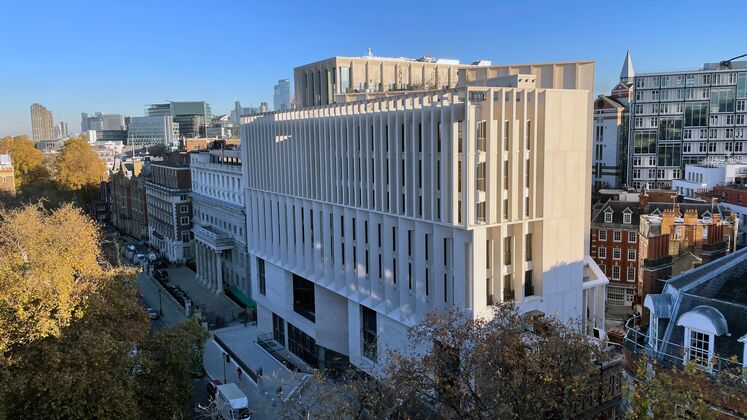by Liv Kessler
Image from LSE Student Blogs
LSE is consistent in its construction. In 2008 it was the redevelopment of the New Academic Building; in 2013, the opening of the Saw See Hock Student Centre. Then, in 2019, the Center Building opened, shiny and full of reflective glass panels. The Marshall Building was 2022’s building of the year, reminiscent of Brazilian brutalism, concrete and all. And now, 35L, soon to be the Firoz Lalji Global Hub (FLGH) Building, is a redevelopment of the Royal College of Surgeons.
It is a common question on campus, one that has rarely found a concrete answer: why does LSE keep building new buildings? This article began as an architectural query, but became a dive into school politics, marketisation, and funding.
Buildings are a part of an LSE renewal over 10 years in the making. This shift has replaced a research-focused postgraduate university into a multicultural hub with a global outreach. This change has been largely positive, more green spaces at LSE, a diverse student body and a more involved university instagram page. It has also created a disconnect between academics and management. The priority is attracting a global market of prospective students, rather than tending to current staff.
This has become more prevalent with new forms of management in the board of directors since 2013, but more acutely since 2017. These can take the form of strategic commitments to sustainability and student experience.
Where does a new building start at LSE? Hopefully, in the External Funding Ethical Review Board. This is the panel responsible for approving large grants to LSE, some of which have gone towards partially funding new buildings. Dr Tim Allen, a member of the board, said that the grants which used to be quasi-non-existent at LSE have now become an important aspect of funding for the school’s day to day. Essentially, “postgraduate fees were keeping the show on the road” for the undergraduate courses. There was a lack of commitment to transparency when it came to funding.
This was made especially clear when the school was targeted by the press for having accepted donations from Libyan dictator’s son Saif al-Islam Gaddafi. With this in mind, the committee has dealt with both approving or rejecting funds that might potentially damage the School’s reputation. The new shift towards Lincoln’s Inn was part of a conscious decision made by the board 10 years ago, “ LSE would have had to move out of central London otherwise”. The choice was clear: either invest in real estate and solicit donations, or keep running a “business as usual” operation and lose the centrality of LSE in favour of cheaper locations elsewhere.
However, this raises the question of whether, to remain afloat, institutions must be continually marketing themselves towards donors. These investments often fall into buildings or specific philanthropically driven programmes like bursaries. The money is not intended for the whole university, though it seems that some investment is better than none. As explained by Tim Allen and Tilly Mason, current General Secretary of the LSESU, it seems as though the funds cannot go to other parts of the school, such as staff pay, pension funds or even amenities for students.
New buildings are also a subtle display of LSE teaching priorities. For instance, Finance, Management and accounting departments appeared to be implicitly favoured for better facilities when selected to occupy the new Marshall Building. Regarding the new building on 35 Lincoln’s Inn Field, Tilly Mason said that the new building would be aimed at providing more space for executive courses. These refer to summer schools or other payment-based, short-term courses. Unsurprisingly, the building will also house the Firoz Lalji Institute for Africa, funded by Firoz Lalji.
This shift in grants has undoubtedly changed the way upper management views the School’s funding and its survival. However, things have also been changing on the ground over the last 10 years. This has been partially credited to the rise of student fees in academia from 2012 onwards. In short, students expect their money’s worth. But along with that also came a rising awareness of issues like sustainability and student experience as attractive ways for universities to market themselves. Buildings, especially at LSE, play an important role in promoting both sustainable agendas and student inclusivity.
It is no secret that sustainability is part of the LSE brand; it’s not just an ethical concern, it’s a selling point. Buildings are an important part of how LSE achieves sustainability, as they tend to be more energy efficient. They are also a key part of how the school markets its sustainable credentials. New buildings become a part of the appeal, branded on websites, pointed out in school tours and remain on the cover of brochures. LSE seemingly continues to walk the line between genuine concern and marketability.
In the time that President and Vice Chancellor Minouche Shafik has been at LSE, many notable changes have come into place. First, two new buildings, CBG and Marshall, as well as the commission of 35L, but also policies such as the Wellness Week. This display of support for student mental health was seen both in Summer term 2022 and at the beginning of Lent Term 2023 with campus-wide initiatives. Like buildings, mental health has become a new focus at LSE. Both estates development and focus on mental wellness present a good image and provide a sense of a university that cares.
The recent creation of a ‘Director of Student Experience’ position on the Board of Directors is another step in this direction. Dr Mark Allinson, the inaugural Director of Student Experience, stressed that his role involved making the LSE spaces, both old and new, as approachable as possible. “And so if you have really good students and really good staff, doing excellent research, bringing that community together, [that] often gets amazing results. But whilst you’re doing that, you might sometimes then neglect other aspects, which are things like wellbeing”. He was clear that “ the pandemic changed things as well. […] I think that it forced higher education to really see things from a more student centred perspective than they’ve done in the past”.
Though these initiatives, like creating a Director of Student Experience or mental wellness weeks are good steps towards inclusivity, some have criticised these more superficial displays of care, as student disability and mental health centres still struggle to provide for the people that need it the most.
New buildings and a new focus on student experience and sustainable engagements have emerged together in an increasing focus of universities as marketable spaces. This is not new or unique to LSE. The need to fund the university has become increasingly pressing, especially as Brexit changes student demographics. There is a scramble to be attractive to those willing to pay, and so prospective students are put at the front and centre.
Despite this criticism, most of the people interviewed agreed on one thing: the university is a nicer place; it has improved in the last 10 years. An emeritus professor, though weary of the many changes, did concede that the buildings had been a necessary addition to the school. For a number of years, LSE students had experienced unadapted classrooms. The Fawcett, Pankurst and Lawrence houses, originally built as offices, are reminiscent of this “old LSE”.
And for what it’s worth, the Marshall Building classrooms are nice, the building is spacious, and it is beautiful.
So why should students care about buildings, sustainability or student experience? In some ways they don’t need to. These processes are happening at the LSE and they are here to stay. They bring the university higher education survey scores. Historically, LSE has had low student satisfaction, something that had been a rumoured cause for director Craig Calhoun’s resignation. In recent years this has shifted due in large part to these university wide efforts as listed above. Student satisfaction scores often influence prospective students as they affect university rankings, a contentious but influential space.
To an extent, there are different priorities at stake. The university has chosen to give importance to its high-earning degrees and to invest in real estate in central London. It has chosen to stay attractive to international students. Despite all its shortcomings, at the end of the day students, and especially alumni, will be the ones benefiting in the long run from this LSE shift, in their CVs, applications and interviews.




